Tillandsia complanata
Click thumbnails for full size, scaled to a new window.
Tillandsia complanata
Species, Ecuador.
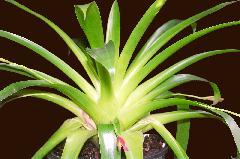
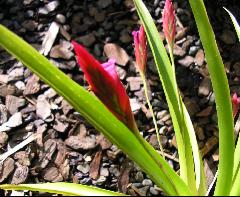
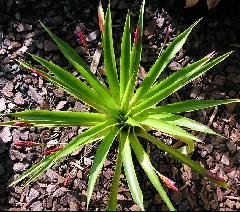
Ken Woods 05/05
Note multiple flowering from leaf bases. |
Richard Harper 10/16
Does not pup. Multiple flowers each year. |
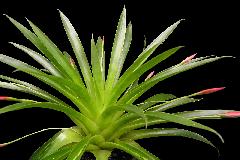
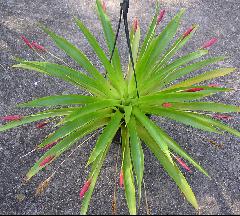
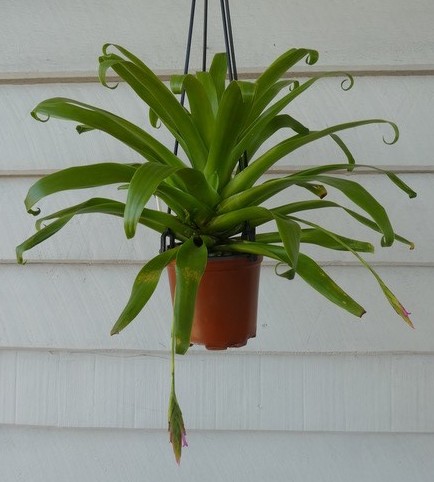
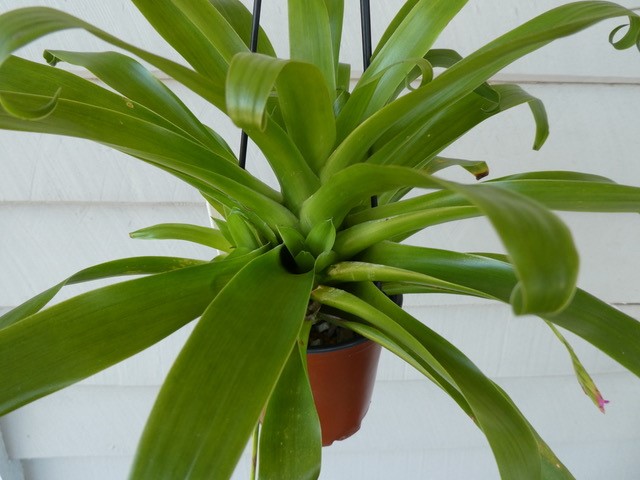
| Ken Woods 10/16 |
Richard Harper 03/19 |
Bruce Dunstan 11/20 |
Bruce Dunstan ... "This T. complanata was seed collected just below El Tulipe, Pichincha, Ecuador in 2017 at 1500m, which is pretty low elevation for this species. Hopefully it will prove to be a strong grower and have some good adaption to hot weather. I’ve noticed it pups pretty prolifically for T. complanata. The plant pictured has 4 pups currently with 1 already removed. A smaller sibling is also producing pups. Thankfully I sent some seed to Bob Hudson and he has produced lots more seedlings than I was able to with lots of disasters befalling my batch growing at work."
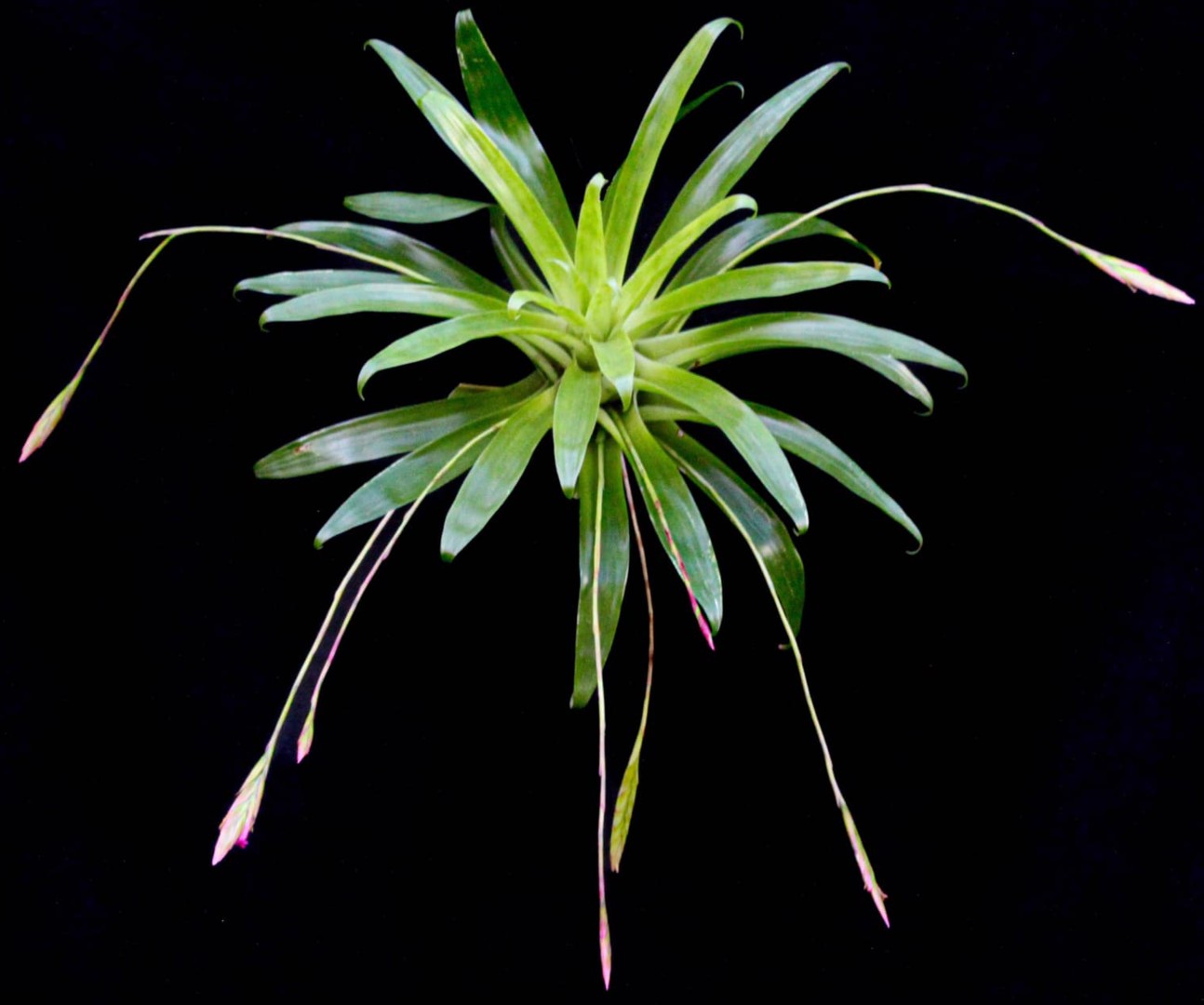
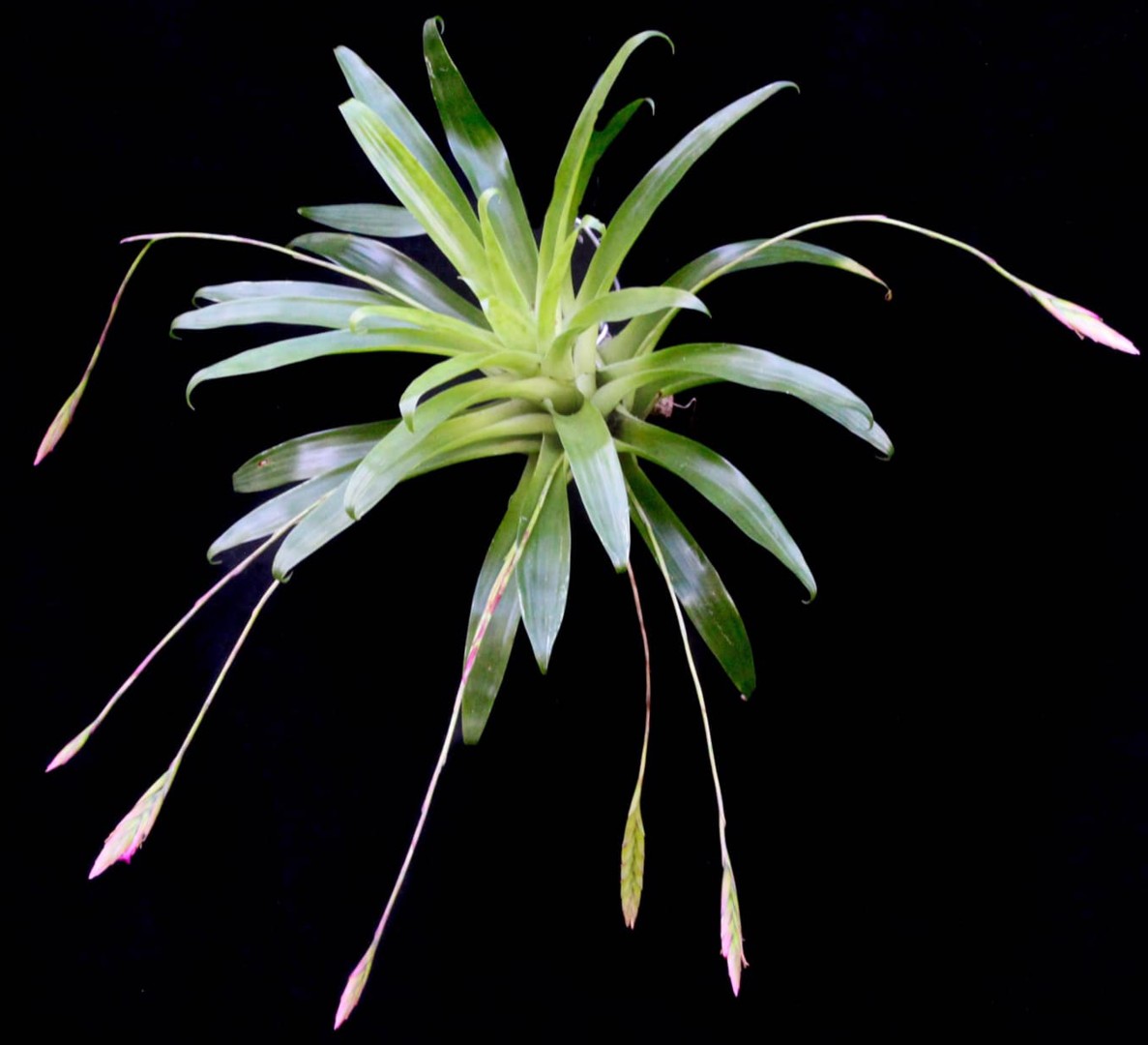
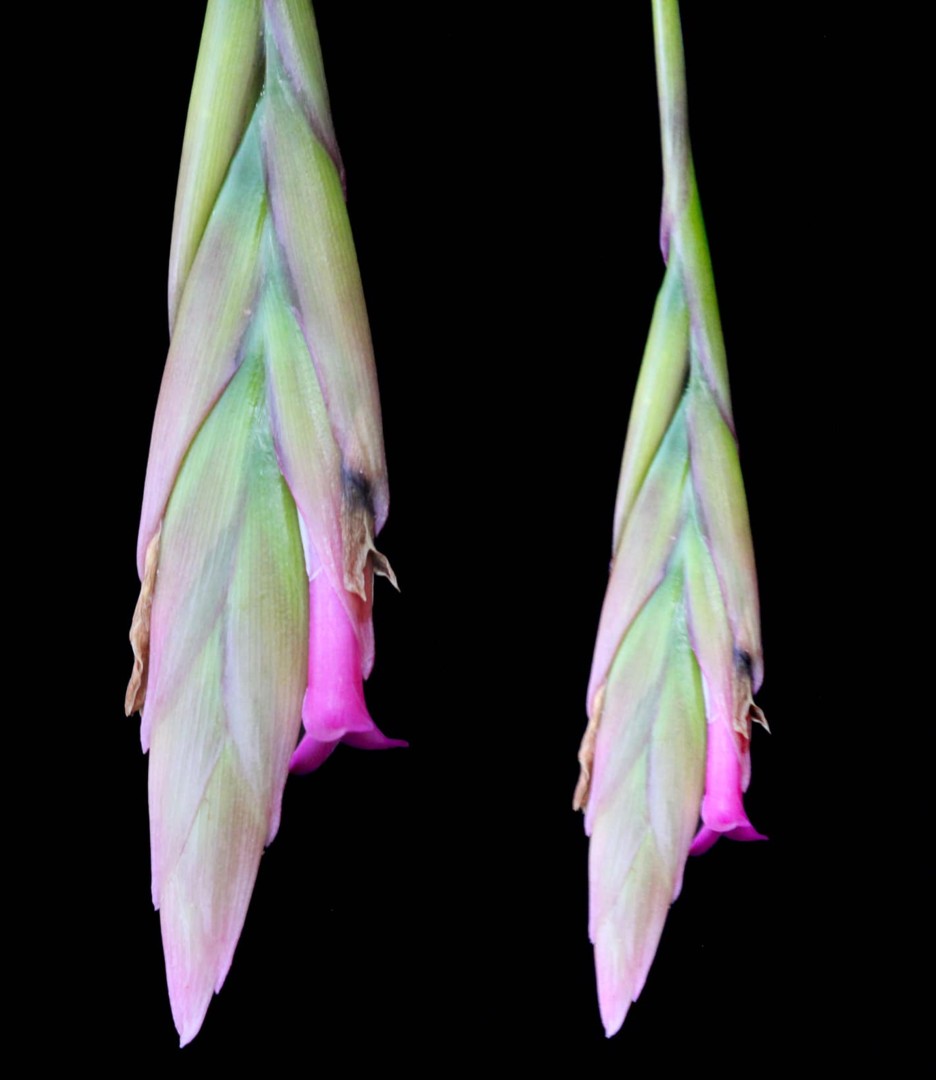
| Bryan Atkins 02/25, El Tulipe |
Tillandsia complanata Bentham, Bot. Sulph. 173. 1846.
Tillandsia axillaris Grisebach, Fl. Brit. W. Indies 597, 1864. Type. Without exact locality, Jamaica, Purdie s n (K).
Desc from S&D p724-6
Plant stemless.
Leaves many in a dense rosette, 3-4 dm long or rarely more, mostly exceeding the inflorescences, spotted, streaked, or suffused with dark purple especially toward the base;
Sheaths elliptic or narrowly ovate, 10-16 cm long, densely and minutely brown-appressed-lepidote;
Blades ligulate, abruptly acute or subobtuse, apiculate 3-5 cm wide, obscurely punctulate-lepidote, soon glabrous above.
Scapes many from the axils of the leaves, ascending then decurved, 1-2 mm in diameter above the flattened base, glabrous;
Scape-bracts numerous, erect, usually imbricate, narrowly lanceolate, acute or acuminate, subchartaceous, glabrous or subglabrous.
Inflorescence simple, lanceolate or linear in outline, acute, densely 4-24-flowered, to 8 cm long, 15-20 mm wide, usually complanate, glabrous.
Floral bracts erect, imbricate elliptic, obtuse, 15-25 mm long, exceeding the sepals, coriaceous or subcoriaceous, even or prominently nerved, ecarinate, often rose or purple;
Flowers subsessile.
Sepals lanceolate, acute, 10-15 mm long, subcoriaceous, the posterior ones carinate and usually much connate;
Petals ligulate, about 2 cm long, rose, purple, or blue, the blade suberect, obtuse;
Stamens and pistil slightly shorter than the petals.
Capsule slenderly cylindric, acute, 4 cm long.
Type. Sinclair s n (holotype K, GH photo), Atacames, Esmeraldas, Ecuador, 1836-39.
DISTRIBUTION. Epiphytic in forest, 800-3500 m alt, Greater Antilles, Costa Rica to Bolivia and northern Brazil.
COSTA RICA. CARTAGO: Cartago 3 Feb 1909, Biolley in Inst. Costar. 17359 {US); 1962, Haines 671 {US); El Mufteco, Navarro, Feb 1924, Standley 33803 {US); Mar 1926, Standley & Torres 51727 {US); Las Concavas, Feb 1924, Standley 35976 {US); Dec 1925, 4 1504 {US); Orosi, 30 Mar 1924, Standley 39953 {US); Tapanti, l5 Jul 1937 , Valerio 17l3 {F); La Carpintera, 23 Mar 1938, Valerio 1720 {F); El Retiro, Santa Cruz de Turrialba, Jan 1941, Valerio 1283 {F); Moravia, Dec 1966, Burger & Ramirez 4023 {F, US). PANAMA. CHIRIQUI: Volcan de Chiriqui, l3 Feb 1940, Terry 1369 {F); Bajo Mona, Quebrada Chiquero, l8 Ju1 1940, Woodson & Schery 602 {GH, MO). CUBA. ORIENTE: Pico Turquino, Sierra Maestra, 17 Apr 19l5, Ekman 5432 {S); 2l Ju1 1922, 14496 {GH, S); Ju1 1922, Leon 11068 {LS, NY); 19 May 1948, Acuna 15062 {SV, US).JAMAICA. PORTLAND: Portland Gap, 30 Apr l894, Harris in Herb. Jam. 5132 {G). ST. THOMAS: Whitfield Hall, 20 Jan 1952, Proctor 6193 {IJ, US). ST. ANDREW: Blue Mountains Park, l2 Dec l890, Hitchcock s n {MO); Newcastle to Hardwar Gap, 29 Jan 1967, Read 1780 {US). COLOMBIA. NORTE DE SANTANDER: divide, Pamp-lona to Toledo, Feb 1927, Killip & Smith 19916 {GH, US); Toledo, Mar 1927, Killip & Smith 20101 {GH, US); Paramo del Hatico, Toledo to Pamplona, Mar 1927, Killip & Smith 20650 {F, GH, US); Sarare, 2l Oct 1941, Cuatrecasas, Schultes & Smith 12567 {US); Ocana to Convencion, 20 Sep 1946, Foster 1747 {GH). SANTANDER: Las Vegas, Dec 1926,Killip & Smith 15930 {GH); La Baja,Jan 1927, Killip & Smith 18099 {GH); 3l Jan 1927, 18782 {GH, US). ANTIOQUIA: Alto de La Union, 24 Ju1 1944, Daniel 3261 {US); Sonson, 30 Oct 1948, Araque & Barkley 18-A-300 {COL, US). BOYACA: La Rusia, Duitama, l4 Nov 1945, Uribe-Uribe 1084 {COL); Duitama to Charla, 29 Aug 1953, Langenheim 3625 {UC, US). CUNDINAMARCA: Salto Camino de Herradura, Garcia-Barriga 124 {COL); Quebrada El Chico, Bogota, 30 Nov 1952, Humbert, Idrobo & Jaramillo 27516 {P, US); Villeta to Utica, l5 Nov 1959, Garcia-Barriga 17198 {COL, US). CALDAS: Pinares, Salento, Aug 1922, Pennell 9223 {GH, NY, US); 9267 {GH, PH, US). VALLE: La Cumbre, Sep 1922, Killip 11350 {GH); road to coast {?), Sep 1939, Dryander 2442 {US); Cuatrecasas 18207 {F, GH). CAUCA: Popayan, Apr l876, Andre 2248 {K); Paletara, Cordillera Central, Jun 1922, Pennell 6978 {GH, PH); San Antonio, Cordillera Occidental, 1 Jul 1922, Pennell 7611 {GH, US); El Tambo, 25 Sep 1939, Sneidern 2071 {S); La Depression, Rio Guaitara headwaters, l7 Sep 1944, Core 1286 {US). NARINO: Paramo del Cumbal, Laguna de Cus¬cungo, 7 Jul 1956, Vogel 274 {US); Pasto, l0 Nov 1962, Mora 2465 {US). PUTUMAYO: Valley of Sibundoy, 3 Jan 1941, Cuatrecasas 11657 {US). VENEZUELA. MIRANDA: Pico de Naiguata,Jun 1945, Steyermark 62981 {F, GH). DISTRITO FEDERAL: El Junquito, 29 Dec 1936, Pittier 13832 {US); Mar 1961, Aristeguieta 4549 {US, VEN); 4 Apr 1962, Steyermark et al 90868 {US, VEN); Cordillera del Avila, 30 Dec 1943, Steyermark 55074 {F, GH). ARAGUA: Colonia Tovar, Fendler 1512 {GOET); 1513 {GOET); May 1934, Pittier 13515 {US); Rancho Grande, l7 Oct 1951, Foster2759 {US); Parque Nacional Pittier, 3 Nov 1962, Steyermark 90992 {US, VEN); 90999 {US, VEN). LARA- TRUJILLO: Paramo de los Nepes, above La Pena, Dec 1959, Barclay & Juajibioy 10275 {US); Quebrada Cortijo, 6 Feb 1944, Steyermark 55336 {F, GH). MERIDA: Sierra del Norte, Oct 1952, Humbert 26668 {P, US); Paramo de Ocucuqui, Pueblo Nuevo, 7 Dec 1952, Bernardi 212 {MER, NY); La Mucuy, 22 Jan 1955, Bernardi 1844 {MER, NY); Merida, l5 Feb 1957, Bernardi 6137 {MER, NY); falls of Rio Gonzales, 3l Aug 1966, Steyermark & Rabe 97053 {US, VEN). TACHIRA. Michelena to Boca de Monte, west of Zum¬bador, 28 Aug 1966, Steyermark & Rabe 96763 {VEN); 96819 {VEN); Rio Quinimari headwaters, l3 Jan 1968, Steyermark & Dunsterville 100824 {US, VEN). BOLIVAR: Cerro Roraima, 30 Sep 1944, Steyermark 58960 {F); Cerro Venamo, 8 Jan 1964, Steyermark & Dunsterville 92873 {US, VEN). TRINIDAD. Aripo, 11 Apr 1922, Broadway 10568 {K, TRIN); 4 Dec 1957 , Aitken & Downs ,5 n {TRIN, US); Valencia, 2 Dec 1927,Broadway 6780 {K); Las Lapas road off Blanchisseuse road, Broadway 7456 {GH); El Tucuche, 1944, Pittendrigh 1237 {US); 1524 {TRIN); El Tucuche to Naranja, 1948, Sim¬monds 234 {TRlN, US). ECUADOR. MANABI: Cerro Monte Cristi, Manta, 10 Aug 1962, Gilmartin 769 {US). GUAYAS: Guayaquil, (Tafalla in herb.) Ruiz & Pavon s n {F); Balao, Dec 1891, Eggers 14055 {L, M, US); Manglaralto, 24 Mar 1962, Gilmartin 644 {US); Guayaquil, 2l Apr 1962, Gilmartin 682 {US); Cerro Azul, Guayaquil, 24 Ju1 1962, Gilmartin 760 {US). ORO: Santa Rosa, 29 Aug 1954, Rauh & Hirsch E-2 {US); 11 Mar 1955, Asplund 15663 {S, US). CARCHI: La Rinconada, Ibarra to Tulcan, Aug 1923, Hitchcock 20945 {GH, US); El Pun to Tulcan, Jul 1955, Asplund 16842 {S, US); 16880 {S, US); Paramo del Angel, 22 JuI 1955, Asplund 17006 {S, US, Z). IMBABURA: Laguna Cuicocha, 23 Jun 1939, Asplund 7145 {S, US); 8 Sep 1945, Acosta Solis 11033 {F); 24 Jan 1953, Prescott 248 {NY). PICHINCHA: Saloya to Quito, 28 Jun 1939, Asplund 7480 {S); May 1952, Universidad Central1600 {M); Oya Cachi, Cordillera Oriental, 26 Oct 1945, Acosta Solis 11131 (F); Quito to Santo Domingo, 9 Dec 1948, Folter 2649 (US). COTOPAXI: Volcan Iliniza, Oct 1858, Wagner 124 (M); Pilalo, Aug 1962, Gilmartin 787 (US); 798 (US). TUNGURAHUA: Patate, 2 Aug 1939, Asplund 8017 (S, US). CHIMBORAZO: Riobamba, 22 Mar 1934, Schimpff 887 (M, MO, US, Z); Dec. 1934, Rimbach 521 (F). CANAR: Azogues, 2 Feb 1945, Camp E-1753 (NY, US); km 45, Cuenca to Loja, 3 Dec 1948, Foster 2629 (US). CANAR-AZUAY: Huigra to Cuenca, Sep 1923, Hitchcock 21671 (GH. US). AZUAY: Cruz Pamba, Banos, Jun 1945, Giler & Prieto in Camp E-3957 (NY, US); junction of Cordillera Occidental and Oriental, 1959, Barclay & Juajibioy 8373 (COL, US); km 40, Cuenca to Loja, 9 Aug 1965, Gilmartin 1111 (US). LOJA: La Toma to Loja, 4 Sep 1923, Hitchcock 21386 (US); San Lucas to Ona, 7 Sep 1923, Hitchcock 21562 (GH. US); Saraguro, Loja, Aug 1959, Harling 6235 (S, US). NAPO: Mera, 1934, Schimpff 706 (MO, Z). PERU. PIURA: Canchague, 26 May 1957 , Ellenberg 1614 (U). AMAZONAS: Bagua Grande to Chachapoyas, 17 May 1962, Ferreyra 14424 (US, USM); Rio Ventilla. Molinopampa, Jul 1962, Wurdack 1492 (US); Tazan, Ingenio to Chachapoyas, 28 May 1963, Lopez, Sagastegui & Collantes 4274 (TRP, US); Pomacocha to Rioja, Bongara, 30 Jan 1964, Hutchison & Wright 3884 (F, UC, US, USM). LORETO: Rogue, Moyobamba, 1925, Melin 331 (S). JUNIN: Huacapistana, 6 Jun 1929, Killip & Smith 24280 (US). BOLIVIA. LA PAZ, Murillo: La Paz, Oct 1885, Rusby 2855 (NY); Larecaja: Mapiri, San Carlos, Sarampiuni, 11 Jan 1927, Buchtien 372 (NY); Hacienda Casana, Tipuani, 1920, Buchtien 7186 (US). COCHABAMBA, Chapare: Antahuacana, Espiritu Santo, Jun 1909, Buchtien 2253 (US); Locotal, 10 Mar 1929, Steinbach 9596 (GH, US). BRAZIL. RIO BRANCO: Mount Roraima, Jan 1910, Ule 8560 (K, MG).
LOCAL NAME. Guicho (Venezuela-Bernardi 212).
NOTES from Gilmartin 1972:
There seem to be three forms of T. complanata that blend into one another;
1) a coastal form represented by smaller plants with floral bracts and sepals having their apices narrowly acute, and sepals posteriorly united;
2) a middle altitude form represented by larger plants, with leaves long and broad, sepals ovate-elliptic;
3) a very high altitude form, a smaller plant with narrow leaves, sepals free and tending to be oblong and obtuse.
Examples of form 1) are;: Eggers 14055 (US), Rauh, Hirsch E 238 (US) AJG 644 (US) and . AJG 682 (US).
Examples of form 2) are: AJG 798 (US), Hitchcock 21671 (US) Camp E, 1753 (US), AJG 787 (US), Foster 2649 (US).
Examples of form 3) are: Camp E 3957A and 13 (US), Hitchcock 21562 (US), Schimpff 887 (US), Barclay and Juajibioy 8373 (US), and Rimbach 282 (US).
Although these three different forms can be recognized, no attempt here is made to describe them as separate taxa.
From the observations of the specimens seen, it appears likely that the so-called simple axial inflorescences of T. complanata are actually spikes of a compound inflorescence with the scape foreshortened so that it never grows to the point of being macroscopically recognizable. In some specimens several "inflorescences" appeared in the same leaf axil as for example with Rivet 687, Schimpff 887 and Camp E 3947. These fascicles of "inflorescences" are probably really spikes with elongate, bracteate stipes. Other specimens, especially the coastal ones, seem to have no more than one "inflorescence," that is, spike, per leaf axil. Support for this idea of a pseudo-simple inflorescence is obtained from the relative lengths of the bracts. In T. complanata what have always been called scape-bracts are often imbricate above but remote below and are approximately all the same length. This is not the usual situation in species of the genus, Tillandsia. Usually scape-bracts are much longer below and imbricate; becoming shorter toward the inflorescence where they may not be imbricate. If we recognize the so-called inflorescences of T. complanata as spikes then the scape-bracts are in reality sterile floral bracts which typically do become closer to one another acropetally. The character of a foreshortened scape is held consistently throughout all forms of Tillandsia complanata that have been observed to date.
Detail from Gouda in Flora of the Guianas 1987
6. Tillandsia complanata Bentham, Bot. Sulph. 173. 1846.
Type: Ecuador, Esmeraldas, Atacames, 1836/39, Sinclair s. n. (holotype K, GH photo). - Plate 3.
Tillandsia axillaris Grisebach, Fl. Brit. W..Indies 597. 1864. Type: Jamaica, without locality, Purdie s. n. (K).
Plant acaulescent, 12-25 cm tall, with a spreading rosette of many pale green leaves, often purple-red streaked or spotted, with (many) inflorescences from the axils of the leaves.
Leaves thin, chartaceous when dry, 16-35 cm long, shorter than to exceeding the spikes;
sheaths ample, but not very distinct, evenly merging into the blades, elliptic, slightly inflated, (5.5-)8.5-15 x (2.5-)4.5-6 cm, brown punctulate- or minutely appressed-lepidote, concolorous pale-green, or in upper part dark purple-red;
blade strongly arching, ligulate or narrowly triangular-ovate, 12-23 x 2.7-3.7 cm, attenuately acute, or obtuse and apiculate, subdensely and minutely appressed-lepidote outside, less so inside.
Inflorescences axillary, simple, 15-40 cm long;
scapes spreading upon the leaves, often decurved, 18-33 cm long, 1-2 mm in diam., glabrous, bracteate, but often partly visible, flat and prophyllate at the base;
scape bracts erect, often remote, membranaceous, linear-lanceolate, the upper ones oblong, apiculate or acutish, mostly shorter than the internodes or slightly exceeding them, glabrous;
spikes oblong to linear, more or less complanate, 3-12 x 0.8-1.2 cm, acute, densely and distichously 3-7(-14)-flowered, with a few sterile bracts at the base and apex;
rachis hidden, flexuous, sharply angled (dry), glabrous;
floral bracts erect, densely imbricate, thin-coriaceous, with even or veined (dry) surface, ovate, 1.4-2.2 cm long, 2-4 times as long as the internodes, much exceeding the sepals, obtuse, ecarinate, glabrous, green, rose to dark¬purple.
Flowers contiguous, sessile;
sepals thin-coriaceous, oblong or lanceolate, 0.8-1.4 cm long, obtuse, posterior ones connate for about 2/3, carinate, strongly incurved at the apex, glabrous;
petals linear spathulate, to 2.5 cm long, the blade subspreading, oblong or lanceolate, rounded, rose, purple or blue;
stamens all alike, somewhat shorter than the petals, exceeding the pistil by half of the anthers, filaments slender and flat, anthers basifixed, sagittate, ca. 4.5 mm long;
ovary slenderly ovoid, evenly tapering, then constricted into the slender style, stigmas linear.
Capsule cylindric (subprismatic), to 4 cm long, about twice as long as the bracts, attenuate, abruptly short-beaked.
Distribution: Greater Antilles, Costa Rica to Bolivia and N. Brazil. Epiphytic in forest, 750-3600 m alt.
13 collections studied. Guyana: Roraima am Abhoiney, E. Ule 8560 (K).
Culture and use: Interesting species because it produces multiple axillary inflorescences and the leaves become purple-red in bloom when grown bright and not too warm, it demands high humidity.
Updated 02/12/20









